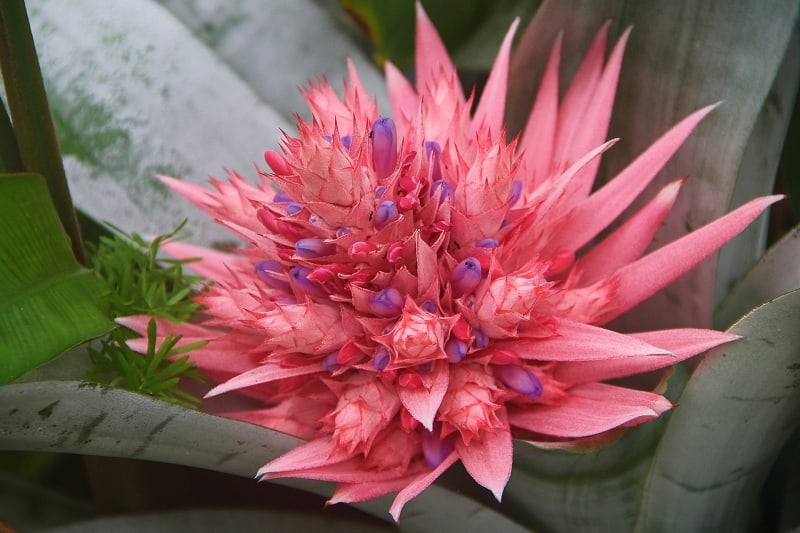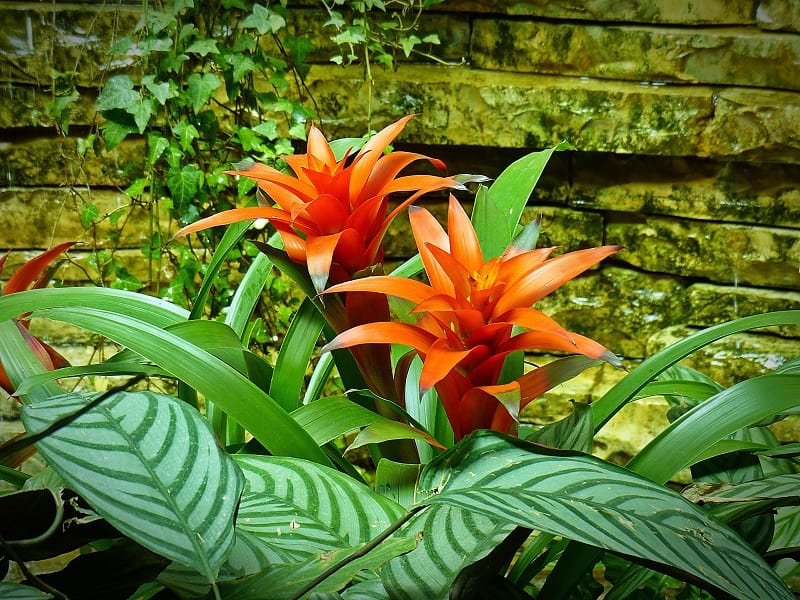Bromeliads have adapted to a wide range of habitats. They are found as epiphytes with almost no roots in tropical rainforests, growing on rocky cliffs in the Andean cloud forest, and as terrestrial specimens on shady forest floors.
All bromeliad share a few features that make caring for them less puzzling. They have thick leaves that are formed in a rosette pattern. Most Plants have a small and shallow root system and thus require extremely well-draining soil. Like orchids, but more forgiving, this plant prefers high humidity as they get most of its nutrients and water from the air once a bromeliad flowers, an inflorescence that lasts several months, the mother plant dies.
| Name | Bromeliad |
| Botanical Name | Bromeliaceae genera |
| Plant Type | Perennials |
| Light | Bright, indirect light |
| Soil | Jungle mix |
| Fertilizer | Balanced fertilizer |
| Bloom Time | Blooms once |
| Problems | Rare |
| Flower Color | purple, orange, yellow |
| Propagation | Cut off pups and plant them in a new pot. |
| Native Area | Tropical and subtropical Americas |
How to Grow Bromeliads
If you want to grow Bromeliads, there are a few things that you need to do. First, you need to select the right place to grow your plant. Make sure that the area has plenty of indirect sunlight and proper airflow. Next, you need to fertilize your bromeliad every week with a balanced fertilizer. Finally, you need to water your plant regularly.

How to Care for Bromeliad
These colorful creatures are living things and need to be treated as such. Bromeliads can live for years in captivity, and some species are hardy enough to be kept outdoors in a tropical climate. Follow these tips for caring for your bromeliad:
- Keep the plant in a warm, bright place and water it regularly.
- Do not over-water or mist the plant. Bromeliads like a moist environment, but do not allow the soil to become soggy.
- Do not touch the plants when they are wet. Bromeliads are susceptible to powdery mildew and other fungus infections when wet.
- If the plant starts to decay, it may be necessary to remove it and start over. Bromeliad leaves yellow and falls off over time, suggesting that the plant is sick or in decline.
Light
It’s important to provide light for Bromeliad, as without it the plants can’t grow properly. This is because plants are photosynthetic, which means that they use sunlight to produce food for themselves.
Soil
Bromeliads need soil that is acidic, moist, and dark in order to grow; this is why you should avoid planting them in direct sunlight. plants can be created in several ways, but the most common is to use a potting mix made specifically for these plants.
Water
Many Bromeliads, like pineapple plants and Jonquils, are adapted to being watered with a soaker hose. A soaker hose droplets the water onto the plant’s root area instead of spraying it high up in the air. This method is more efficient and less wasteful because the water droplets fall directly onto the root zone where it is most needed.
Humidity
These plants need high humidity levels in order to flourish, but too much humidity can be damaging.
The high humidity levels required by plants encourage the growth of proteas, while the low humidity levels kill off other plants and Insects.
Temperature
The temperature for Bromeliad plants can be variable depending on the location and time of year. Arguably the most variable part of this plant’s behavior is the temperature range in which they thrive. In general, tropical plants prefer warmer temperatures and cooler this plant prefer cooler temperatures. In regions where winter temperatures are below freezing, Bromeliad may not grow or produce flowers.
Fertilizer
Many bromeliad plants need fertilizer to grow and thrive. Different fertilizers are needed for different types of bromeliads, so it is important to know which fertilizer is right for your plant before buying it. Some of the most common fertilizers needed for bromeliad include potassium, nitrogen, phosphorus, and magnesium.
Potting & Repotting
There are a few things that you need to do when potting or repotting a bromeliad plant. The first is to make sure that the plant is well-drained. Next, you will want to make sure that the soil is of the correct pH and texture. Finally, make sure that the plant has the proper exposure to sunlight and humidity.
Common Pests
There are many types of pests that can affect bromeliad plants. Some of the most common pests include aphids, beetles, caterpillars, coccids, earwigs, leafhoppers, moths, nematodes, Publishers, and spiders. While most of these pests will only cause minor damage, a few can cause significant damage to a bromeliad plant, leading to its demise.
Common Diseases
There are many diseases that can plague bromeliad plants. These diseases can have a significant impact on the health and vitality of the plants, resulting in reduced growth and possible death. Some of the most common bromeliad diseases are listed below.
- Rot: This is a deadly disease affecting various types of plants, including bromeliads. Rot causes the plant to wilt and die, typically due to a lack of water and nutrients. Rot is most often caused by cold environments, drought, or poor drainage. It can be prevented or cured by providing the plants with the necessary water and nutrients, as well as proper ventilation.
- Fungal Infections: Fungal infections are also common among bromeliad plants, and can cause a wide range of symptoms. Some common symptoms include localized leaf infection, wilting, and stunted growth. In some cases, the fungus can kill the plant outright. Prevention and treatment of fungal infections depend on the specific type of fungus involved.
- Yellowing & Dieback: Yellowing and dieback are similar diseases that can affect bromeliad plants. Symptoms typically include yellowing of the leaves and plant tissues, as well as dieback of the branches and roots. In severe cases, the entire plant may die. Treatment usually involves the fungicidal treatment, foliar spraying, and/or root corrective surgery.
Propagating
To propagate bromeliad plants you will need a pot with a good drainage hole, rooting hormone, and stem cutting. After planting the bromeliad in the pot, add water and root hormone. Keep the bromeliad well watered and fertilize it once a month with diluted weak fertilizer.
Growing Bromeliads From Seed
Bromeliads can be grown from seed, but there are a few things to keep in mind when doing so. First, make sure that the bromeliad you choose is appropriate for growing in your climate. Second, presoak the seed in water for at least 24 hours before planting. Finally, keep the bromeliad growing medium evenly moist and temperatures between 68 and 80 degrees Fahrenheit are ideal.
FAQ
What is a bromeliad?
A bromeliad is a flowering plant that typically consists of a single stalk with a number of ascending, tube-shaped leaves. Bromeliads originate from the same family as coleus and ginger, the Bromeliaceae. Bromeliads are considered unusual plants because they possess water droplets on the leaves and bark that allows the plant to adapt to a variety of climates and soils. Bromeliads are popular garden plants, and some species are used as ornamental plants.
What are the different types of Bromeliads?
There are many different types of Bromeliads, but the most common are species of the genus Tillandsia. Bromeliads are succulent plants that typically grow in areas with high humidity, such as rainforests. Some Bromeliad species are edible, while others are used as ornamentals.
What is the life cycle of a Bromeliad?
Bromeliads are plants that grow from a small root system and are attached to a rock or wood particle. They can live for many years, but usually only a few months at a time. Once the bromeliad blooms, the petals fall off, the flowers die, and the bromeliad goes back to a state of roots and a new bud.

